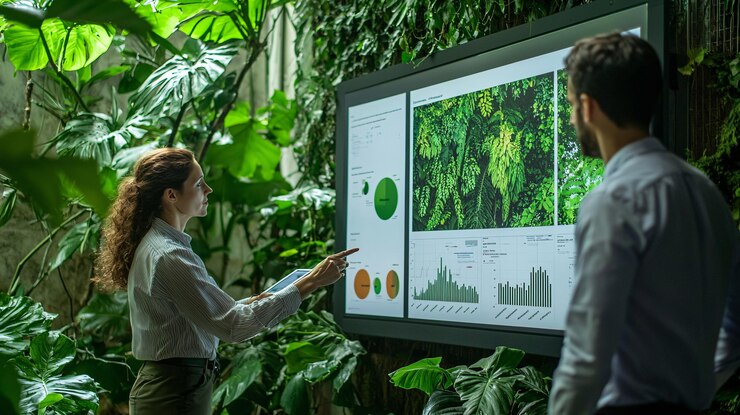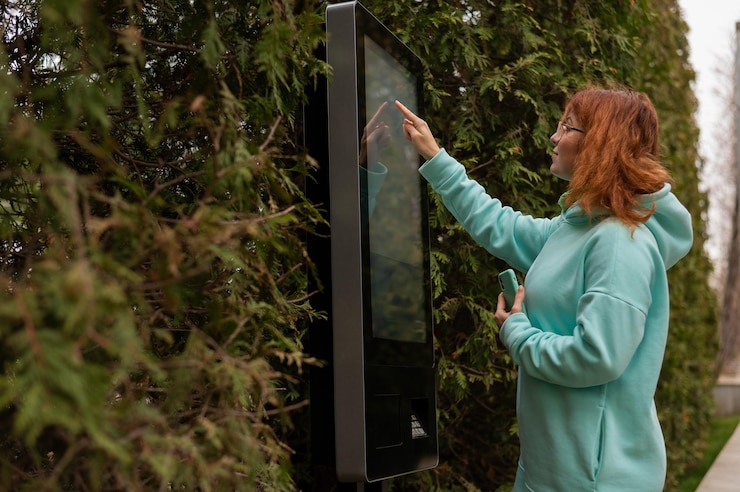The old paper playbook doesn’t scale, and it definitely doesn’t age well. Ink fades. Flyers pile up. Waste bins overflow with yesterday’s promos.
But here’s the bigger issue: those print-based habits are burning through resources most teams don’t measure. Energy, waste, emissions — all balloon quietly behind the scenes. And the shift toward sustainable operations? It’s happening with or without you.
That’s where digital signage steps in and strips the waste out of communication. Not as a gimmick. As a system. One that cuts paper use to zero, slashes recurring energy loads, and reduces the carbon footprint baked into print logistics.
So if you’re stuck in a loop of print orders, manual updates, and high overhead, this post will break down how switching to digital signage cuts waste, trims energy use, and puts environmental control back in your hands.
Here’s what we’ll break down:
- How digital signage reduces paper, ink, and chemical waste
- The difference in carbon emissions between print and digital media
- Why energy-efficient displays now outperform legacy screens
- How content automation reduces labor, transport, and overhead
- How digital signage supports ESG goals and green certifications
- What role does CrownTV play in shrinking operational impact
Let’s get started!
Paper Waste Piles Up Faster Than You Think
Most businesses don’t track how much paper they burn through on signage, but they should. Between menus, sales flyers, announcements, posters, brochures, event signage, and compliance notices, the volume stacks up quickly. Multiply that across multiple locations, with weekly or seasonal refresh cycles, and you’ve got a recurring waste stream that’s both expensive and environmentally reckless.
What starts as a “low-cost print job” turns into a monthly cycle of wasted paper, ink, plastics, and chemical-treated substrates. And that’s not counting the extra labor needed to hang, update, and tear down physical signage — or the emissions involved in delivering those materials.
Where Print-Based Signage Takes a Toll
- Let’s break it down by material load:
- Paper: From bleached office stock to laminated posters, most paper signage is designed for short-term use and gets tossed within days or weeks.
- Ink: Petroleum-based inks release volatile organic compounds (VOCs), which are harmful to both indoor air quality and the environment.
- Plastics: Laminates and foam boards used for durability don’t decompose, and they often end up in landfills or incinerators.
- Chemicals: Toners, UV coatings, adhesives, and fixatives contribute to environmental toxicity and are rarely disposed of properly.
Now add up the transport and supply chain footprint tied to replenishing these materials, and you’re looking at a system that outputs far more than it brings back in.
Why It Matters
Digital signage replaces this recurring cycle with a closed-loop system. Once the screen is in place, updates happen digitally — no mess, no printing, no repeat supply chain dependency. That means:
- Fewer trees are cut for temporary signage
- Less ink and toner demand in high-turnover industries
- Lower landfill pressure from short-term promotional materials
- Fewer chemicals are introduced into indoor environments
How Print and Digital Media Compare on Carbon Output

Not all emissions come from smokestacks. Some hide in toner cartridges and shipping pallets. Print media carries a heavier carbon footprint than most teams expect. That’s because the impact doesn’t stop at the printer. It starts at raw material extraction and runs through production, transportation, usage, and disposal — a full life cycle that repeats every time a poster or menu gets refreshed.
Print Media’s Carbon Chain
Every printed sign carries a trail of emissions:
- Pulping and bleaching for paper production
- Ink manufacturing, including solvents and chemical stabilizers
- Machinery power use for both bulk and in-house printing
- Packaging and shipping to distribute signs to each location
- Replacement cycles that create continuous demand and waste
- End-of-life disposal that adds to landfill methane emissions
These steps don’t scale efficiently. The more signs you need, the more emissions you generate — and the cycle repeats with every update.
Digital Media Runs a Different Equation
The carbon profile for digital signage is front-loaded. Most emissions come from:
- Hardware manufacturing
- Shipping and installation
- Energy consumption during display use
But once installed, the recurring footprint stays fixed — content updates don’t add more emissions. You’re no longer driving demand for new materials, and you’re not paying for logistics each time messaging changes. And with efficient LED technology and power-saving screen modes, modern displays can run with surprisingly low energy loads, especially when timed and zoned properly.
Emissions Over Time
If you’re comparing one month of usage, the gap might feel small. But stretch that over a year, or scale it across multiple branches, and digital signage starts cutting out emissions that print would keep pushing forward.
The long-term gains come from breaking that print-and-replace loop — and replacing it with a system that updates content without adding carbon cost.
Energy-Efficient Displays Are Quietly Outperforming the Old Guard
Legacy screens were built for brightness. Not efficiency. Older models — especially CCFL-backlit LCDs and early plasma displays — pushed hard on wattage and heat, chewing through power even during low-demand use. Their operating cost didn’t end at the power bill either. Cooling systems worked harder. Lifespan dropped faster. And performance degraded long before the hardware itself failed. Today’s energy-efficient displays are built differently.
What Modern Displays Cut Out
Modern energy-efficient displays aren’t slimmed-down versions of old tech — they’re engineered from the ground up to eliminate wasted wattage, excess heat, and static operation overhead. This optimization doesn’t stop at the panel. It runs through every layer of the system architecture, including the power supply, backlight control, processing board, and thermal management.
Let’s break down what these displays remove from the equation:
- Over-illumination from static backlighting: Older CCFL (cold cathode fluorescent lamp) systems ran with fixed backlights. Power draw remained constant regardless of content brightness or ambient lighting. Today’s LED edge-lit and full-array local dimming systems adjust brightness dynamically. Luminance levels throttle down automatically in low-light zones or when darker content is displayed, which means power consumption follows actual use, not theoretical max output.
- Excessive refresh cycles: Displays like OLED and e-paper panels reduce energy consumption by targeting refresh behavior. OLED only powers individual pixels that are active, so black backgrounds consume almost no energy. E-paper displays hold an image without any draw until content is refreshed — ideal for schedules, directories, or static notices.
- Inefficient color reproduction pipelines: Legacy panels often struggled with accurate color rendering, requiring intense processing and higher brightness to compensate. Modern IPS and OLED panels use wider color gamuts (DCI-P3, Rec. 709) with less processing strain, cutting draw while still delivering precise color fidelity.
- External cooling dependencies: Newer commercial displays integrate passive or low-draw thermal regulation systems that reduce or eliminate the need for HVAC compensation. Lower thermal output means screen enclosures stay cooler and systems avoid running HVAC fans at full throttle in closed environments.
- Always-on standby draw: Modern displays with smart power management include auto-off timers, ambient light sensors, motion-triggered activation, and remote shutdown features. When they’re not needed, they don’t burn power idly.
How Legacy Screens Fall Behind
Legacy screens — particularly older plasma, CCFL-LCD, and first-generation commercial displays — were designed with baseline performance in mind, not energy optimization. That design gap becomes obvious when scaled to multi-location setups or 24/7 environments.
Here’s where older screens create long-term inefficiencies:
- Constant full-power operation: Without ambient or content-aware dimming, older displays operate at maximum power draw regardless of environmental needs. There’s no modulation based on time-of-day, viewer proximity, or on-screen content type.
- High thermal output with poor dissipation: Legacy commercial displays often produced significant heat due to inefficient power supplies and pixel architectures (especially in plasma displays). These units required additional cooling, either through internal fans that drew extra power or via external environmental HVAC systems.
- Shorter operational lifespan: Many older displays were built to run between 20,000 to 30,000 hours before brightness loss or pixel degradation impacted usability. Modern LED and OLED commercial-grade displays now reach 50,000+ hours, often with L70 or L80 certification, meaning screen performance stays at 70–80% brightness even at the end of life.
- No smart scheduling or power control integration: Without modern CMS or API-based control systems, legacy units rely on manual power cycles. That leads to inconsistent runtime, accidental overuse, and zero data tracking on energy trends — a blind spot in energy reporting and environmental accountability.
- Incompatibility with modern energy standards: Older screens often fall short of today’s Energy Star, TCO Certified, or RoHS-compliant requirements. This makes them nonviable for businesses pursuing LEED points or corporate sustainability reporting standards.
When you’re running dozens of screens — or even just one high-traffic display — the difference in draw adds up quickly. Modern panels don’t need to be switched out for every improvement cycle. They handle content changes efficiently, run cooler, and use less energy per hour of output.
This is where energy-efficient displays pull ahead. Not because they cut corners, but because they cut out the waste.
Content Automation Cuts More Than You Think

Most costs tied to signage don’t show up on the invoice — they show up on the clock. Manual updates pull time away from higher-value work. Coordinating shipments, approving new print runs, distributing signage across multiple branches — it’s all slow, repetitive, and inefficient. And the bigger your footprint, the worse that friction gets. This is where content automation shifts the model entirely.
Labor Gets Pulled Out of the Equation
Manual signage workflows lock teams into labor-intensive cycles. These cycles absorb time across multiple departments — from creative, compliance, and procurement to on-site staff. And they repeat every time a message needs to change.
Let’s break down the labor footprint of a traditional signage process:
- Creative Development: Involves designing, formatting, and revising content for multiple aspect ratios and formats.
- Approval Workflow: Requires multi-tiered sign-off from marketing, legal, or compliance teams, especially in regulated industries.
- Print and Production Coordination: Needs vendor alignment, quote approvals, and production timelines.
- Physical Deployment: Staff at each location unpack, mount, replace, and confirm signage, often with inconsistencies in execution.
- Disposal of Old Materials: Adds an extra step of teardown and waste handling.
In digital signage environments, content automation centralizes all of this. Using a content management system (CMS), a single user can:
- Pre-schedule content updates across zones, dates, and screen types
- Apply brand templates uniformly with auto-scaling to match display specs
- Trigger location-specific variations using pre-set rules (e.g., by region, time, or SKU availability)
- Set automated expiration dates for outdated messages
The result is a fully programmable, rule-based content engine that eliminates redundant manual inputs. Labor costs don’t just drop — they stop scaling with content volume.
Transport Drops Off the Ledger
Every print cycle carries a logistics burden, especially in distributed operations. This includes material movement, storage, coordination, and tracking, all of which burn budget and inflate emissions.
Here’s how the transport overhead stacks up in traditional models:
- Inbound logistics for raw materials or pre-printed signage
- Warehousing requirements to store signage between production and deployment
- Outbound delivery to hundreds or thousands of physical locations
- On-site coordination for delivery windows, receipt confirmation, and local installation
Each update creates new freight volume, tracking load, and administrative overhead. Print signage doesn’t scale — it compounds.
Digital signage platforms with automated content deployment remove this category entirely. Updates travel through encrypted data channels, not trucks. There’s no physical inventory, no delays from supplier backlogs, and no exposure to fuel price volatility.
And for businesses operating across geographies, this has a second-order benefit: decentralized content can still be controlled centrally, without needing boots on the ground. It’s a full removal of a transport-dependent model, not a reduction.
Overhead Shrinks Across Departments
Print signage isn’t just a marketing expense — it quietly pulls resources from procurement, legal, facilities, operations, IT, and even finance. Each update triggers a multi-departmental ripple effect that adds friction to basic communication.
Here’s where legacy systems tie up internal bandwidth:
- Procurement handles vendor selection, cost negotiation, and PO management
- Legal and Compliance must review and approve physical assets that can’t be remotely pulled once deployed
- Operations coordinates site readiness, distribution timelines, and signage lifecycle
- Facilities manage screen setup, mounting hardware, and spatial integration
- IT provides support for screen control in hybrid environments
- Finance reconciles recurring orders, delivery inconsistencies, and overages
Automated digital signage reduces or outright eliminates these dependencies.
- Procurement shifts to one-time hardware acquisition, not recurring consumables
- Legal can approve content templates, not each variation
- Facilities are installed once, updates happen without physical interaction
- Operations and finance gain predictable cost structures with fewer surprises
- IT manages centralized systems with remote support capabilities and system-wide health monitoring
The system transforms from a cross-functional burden into a self-sustaining communication asset — one that scales content updates without pulling new cycles from each department.
Meeting ESG Goals Starts with Smarter Display Strategy

Environmental, Social, and Governance (ESG) goals have shifted from aspirational benchmarks to measurable obligations — especially for U.S.-based companies operating under shareholder scrutiny, SEC climate disclosure requirements, or sustainability-linked performance contracts.
ESG reporting requires companies to track and improve their environmental impact, foster social responsibility, and maintain governance standards. These metrics aren’t abstract. They’re directly tied to funding, stakeholder trust, and market positioning.
On the environmental side, this typically includes:
- Energy efficiency
- Waste reduction
- Carbon emissions tracking
- Sustainable procurement
Green certifications are formal acknowledgments of those efforts. In the U.S., this includes well-established programs such as:
- LEED (Leadership in Energy and Environmental Design): Focuses on sustainable building materials, energy usage, water efficiency, and waste diversion.
- Energy Star Certification: Applies to equipment and infrastructure that meet strict energy performance standards.
- WELL Building Standard: Measures health and environmental impacts within occupied spaces.
- Green Globes and BREEAM: Provide third-party assessment on operational sustainability.
These frameworks reward measurable reductions in energy use, emissions, and waste — all of which tie directly to how visual communication systems are managed.
How Digital Signage Fits Into ESG and Certification Criteria
Traditional signage systems — print-heavy, manually updated, and labor-intensive — conflict with nearly every environmental metric that ESG frameworks measure.
Digital signage systems reduce that friction across multiple pillars:
1. Environmental Performance
- Energy-efficient displays lower operational power consumption
- Automated content updates eliminate logistics emissions tied to freight and physical distribution
- Reduction in consumables (paper, ink, vinyl) leads to waste stream minimization
- Remote management cuts on-site servicing and associated transport emissions
These inputs align directly with LEED’s Energy and Atmosphere credits, WELL’s Air and Light features, and general GHG accounting requirements under Scope 2 emissions tracking.
2. Social Impact
Digital signage also contributes to the S (social) in ESG by improving:
- Health and wellness through reduced chemical exposure (no VOCs from printed ink or adhesives)
- Workplace equity by removing labor-intensive roles tied to signage replacement
- Information transparency for employees and visitors via live updates on screens without manual effort
These benefits matter for WELL and other frameworks that track occupant wellness, communication effectiveness, and inclusivity.
3. Governance and Accountability
Sustainability isn’t credible without data. Digital signage platforms often support:
- Remote diagnostics and uptime reporting
- Audit logs of content pushes
- Tracking of power usage and performance baselines
This gives organizations the traceable records required for sustainability reporting under ESG frameworks or voluntary reporting platforms like GRESB or CDP.
Digital signage doesn’t check one box — it removes friction across the board, supporting measurable progress toward multiple ESG targets while contributing to green building certifications that improve operational reputation and financial positioning.
How CrownTV Reduces Operational Load and Supports Environmental Efficiency
Reducing environmental impact isn’t only about what’s visible on screen — it’s about how efficiently that screen fits into your operations. CrownTV approaches environmental stewardship through control, automation, and hardware optimization. Every component in the system is designed to reduce waste, trim excess usage, and support energy-aware infrastructure without adding complexity to your workflow.
The result? A system that delivers sustainable digital signage solutions — not theoretical ideas, but tangible changes you can scale.
Hardware That Works Smarter, Not Harder
The efficiency of a typical digital signage system starts with the hardware at its core. Generic media players, makeshift mini-PCs, or consumer-grade devices often introduce inefficiencies that go unnoticed—until they start dragging down system performance or bloating energy bills.
CrownTV’s dedicated eco-friendly digital signage players are engineered specifically for commercial-grade deployment. Unlike multi-purpose hardware that splits resources across irrelevant functions, these units operate with stripped-down OS environments, solid-state architecture, and thermal efficiency frameworks designed for 24/7 uptime with significantly less power.
Key advantages include:
- Hardware-level decoding of 4K and HTML5 content without relying on CPU-intensive software processing
- Passive cooling enclosures that eliminate the need for internal fans, reducing moving parts, power use, and maintenance points
- Low-voltage, energy-efficient LED technology power supplies with built-in regulation against draw spikes
- Remote reboot, performance tracking, and failover support, minimizing truck rolls and on-site service calls
This isn’t about lowering specs — it’s about building a purpose-tuned system that matches the environmental demands of many digital signage systems.
A Platform That Centralizes Control
Decentralized signage systems force operations teams into fragmented workflows. One site runs USB-driven content. Another uses a basic CMS with no remote capabilities. A third relies on spreadsheets to coordinate weekly updates. This fragmentation leads to inconsistent messaging, duplicated labor, and excess energy usage from mismanaged screen runtimes.
CrownTV’s digital signage software resolves that by providing a centralized content command layer, hosted securely in the cloud and accessible from any authenticated terminal.
The platform supports:
- Granular scheduling by device, time, zone, or business unit — no wasted screen hours
- Live overrides and emergency messaging, eliminating the need for site-by-site intervention
- Auto-expiring content blocks that prevent outdated information from looping
- Remote diagnostics and player health status to detect inefficiencies before they escalate
With centralized control, organizations remove the inefficiencies that come from manual syncing, unnecessary display uptime, and redundant labor. Every screen runs clean, current, and as scheduled, with adopting digital signage becoming an operational upgrade, not a tech burden.
Integration That Cuts Redundancy
Siloed systems generate waste. When teams duplicate workflows — pulling data into design software, exporting static files, uploading them manually into basic players — the result is content that lags behind reality. Staff spend time fixing gaps instead of delivering forward motion.
CrownTV’s integration ecosystem removes that inefficiency by connecting to:
- Cloud-based calendars for auto-updated schedules
- Live data APIs for sales KPIs, inventory stats, and service queues
- Social media feeds for real-time engagement
- Environmental systems like weather, traffic, and occupancy sensors
These integrations automate refreshes and reduce back-and-forth between departments, helping teams cut greenhouse gas emissions tied to unnecessary coordination, transport, and print processes. They also make it easier to implement sustainable practices without adding overhead.
Messaging reflects what’s happening — live, localized, and aligned with your actual operations — instead of being stuck in manual revision cycles.
Installation That Supports Energy Awareness from Day One
Energy performance doesn’t start at the CMS. It starts at installation. Misplaced screens lead to brightness overcompensation, component fatigue, and lower ROI. That means more service calls, higher consumption, and unnecessary electronic waste over time.
CrownTV’s installation service builds the system for efficiency from the start:
- Ambient light mapping prevents screen overdrive in high-glare zones
- HVAC interaction checks avoid heat exposure or overcooling
- Line-of-sight optimization aligns content with human traffic patterns, not theoretical zones
- Clean cable routing minimizes power fluctuations and signal degradation
This kind of deployment makes LED displays more than a display medium — they become digital solutions that reduce waste generation, shrink your environmental footprint, and support alignment with renewable energy sourcing strategies wherever possible.
By placing your signage system where it performs best, not simply where it fits, CrownTV helps businesses adopt eco-friendly practices that cut costs, labor, and emissions from day one.
Shrink Waste and Boost Efficiency With Smarter Digital Signage
Sustainability isn’t just a policy line — it’s a systems issue. And switching to digital signage clears out one of the most overlooked sources of operational waste in modern businesses.
You’ve now seen where traditional signage strains resources, where emissions hide behind print cycles, and how modern displays, automation, and data-driven workflows offer an environmental edge that actually scales.
The environmental benefits aren’t theoretical. They’re built into the infrastructure — from how content is managed to how hardware is installed and maintained. And with the right digital signage system in place, teams can shrink their footprint without creating new friction across departments.
Here’s a recap of what we broke down:
- How paper, ink, and chemical waste stack up in traditional signage
- The emissions gap between printed media and digital displays
- Where energy-efficient screens like OLED outperform legacy technology
- Why content automation reduces labor cycles, shipping demands, and coordination overhead
- How digital signage aligns with ESG benchmarks and green certifications
- What CrownTV offers to remove operational drag and support environmental performance, from signage players and software to app integrations and professional-grade installation
Smart changes don’t need to create more complexity. CrownTV gives you a system that cuts waste, cleans up content operations, and sets you up to meet your environmental goals with precision, not guesswork.

